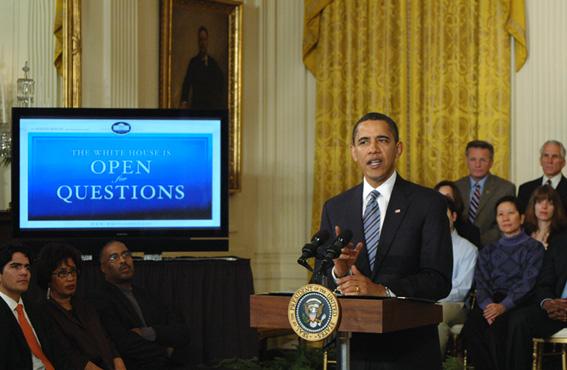| The beginning of any administration is a time of many
firsts. On
January 26 Obama did his first formal interview as President,
speaking not to an American network, but with Al Arabiya. On
January 27 Obama made his first trip to
Capitol Hill, holding meetings with House and Senate Republicans to
promote his economic stimulus plan. On January 28,
with
wars continuing in Afghanistan and Iraq, Obama made his first trip to
the Pentagon as commander-in-chief. On January 29 he signed
his first piece of legislation, the Lilly Ledbetter Fair Pay
Restoration Act. On February 9 he held his first news conference
as President. On February 20 he made his first trip overseas
as President, visiting Ottawa, Canada for about six hours. On
February 22, the Obamas hosted their first State Dinner, feting the
nation's governors who were in town for their annual meeting. On
February 24 he met with Japanese Prime Minister Taro Aso, his first meeting with a
foreign leader at the White House. On April 20 he held his first
Cabinet meeting. |
 |



 On
February 26 he released an outline or blueprint of
his first budget (remarks,
reactions). "A New Era of Responsibility" outlined the
specific
investments in energy, health care and education that the
Administration proposed. Obama declared that, "While we must add
to our deficits in the short term to provide immediate relief to
families and get our economy moving, it is only by restoring fiscal
discipline over the long run that we can produce sustained growth and
shared prosperity." All told the
plan
called for outlays of $3.55 trillion in FY 2010 and a deficit
of $1.17
trillion after
spending of $3.94 trillion in FY 2009 and a deficit of $1.75
trillion.
On
February 26 he released an outline or blueprint of
his first budget (remarks,
reactions). "A New Era of Responsibility" outlined the
specific
investments in energy, health care and education that the
Administration proposed. Obama declared that, "While we must add
to our deficits in the short term to provide immediate relief to
families and get our economy moving, it is only by restoring fiscal
discipline over the long run that we can produce sustained growth and
shared prosperity." All told the
plan
called for outlays of $3.55 trillion in FY 2010 and a deficit
of $1.17
trillion after
spending of $3.94 trillion in FY 2009 and a deficit of $1.75
trillion. 